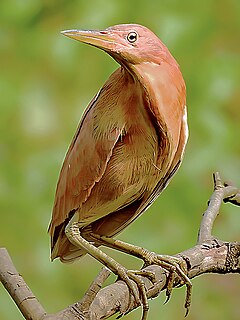
The cinnamon bittern or chestnut bittern is a small Old World bittern, breeding in tropical and subtropical Asia from India east to China and Indonesia. It is mainly resident, but some northern birds migrate short distances.

The russet sparrow, also called the cinnamon or cinnamon tree sparrow, is a passerine bird of the sparrow family Passeridae. A chunky little seed-eating bird with a thick bill, it has a body length of 14 to 15 cm (5.5–5.9 in). Its plumage is mainly warm rufous above and grey below. It exhibits sexual dimorphism, with the plumage of both sexes patterned similarly to that of the corresponding sex of house sparrow. Its vocalisations are sweet and musical chirps, which when strung together form a song.

Crypturellus is a genus of tinamous containing mostly forest species. However, there are the odd few that are grassland or steppe tinamous. There are 21 species of and a total of 67 taxa.

The thicket tinamou or rufescent tinamou is a type of tinamou commonly found in moist forests in subtropical and tropical central Mexico.
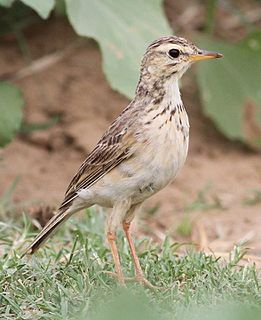
The African pipit is a fairly small passerine bird belonging to the pipit genus Anthus in the family Motacillidae. It is also known as the grassveld pipit or grassland pipit. It was formerly lumped together with the Richard's, Australasian, mountain and paddyfield pipits in a single species, Richard's pipit, but is now often treated as a species in its own right.

The cinnamon bracken warbler is a species of Old World warbler in the family Locustellidae. It is found in Burundi, Democratic Republic of the Congo, Ethiopia, Kenya, Malawi, Mozambique, Rwanda, South Sudan, Tanzania, Uganda, and Zambia. Its natural habitats are subtropical or tropical moist montane forests and subtropical or tropical moist shrubland.

The cinnamon attila is a species of bird in the family Tyrannidae, the tyrant flycatchers. It is found in northern South America in the Amazon Basin of Brazil and the Guianas. It is found in Brazil, Colombia, Venezuela, Guyana, Suriname, and French Guiana; also Amazonian Ecuador, Peru, and regions of Bolivia. Its natural habitat is subtropical or tropical swamps.

The cinnamon ibon is a species of bird endemic to the mountains of Mindanao in the Philippines. Monotypic within the genus Hypocryptadius, it is classified as a sparrow after being tentatively placed in the white-eye family Zosteropidae. Its natural habitat is tropical moist montane forests and mossy forests above 1,000 metres (3,300 ft). It has a skull and bill similar to that of the sparrows, and following a study of its mitochondrial and nuclear DNA as well as skeletal evidence, Jon Fjeldså and colleagues placed the species as the most basal member of that family and a distinct subfamily.

The cinnamon flycatcher is a species of bird in the family Tyrannidae. It is the only member of the genus Pyrrhomyias.

The chestnut piculet is a species of bird in the family Picidae. It is found in northern Colombia and north western Venezuela.
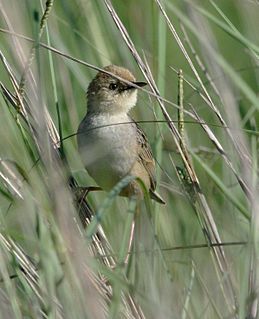
The pale-crowned cisticola is a species of bird in the family Cisticolidae.

Cortinarius cinnamomeus, also known as the cinnamon webcap, is a basidiomycete mushroom of the genus Cortinarius. The fungus produces brown fruit bodies with caps up to 6 cm (2.4 in) wide and stems up to 12 cm (4.7 in) long. The closely crowded gills underside the cap are initially yellow before turning brown. Cortinarius cinnamomeus is common in damp places in coniferous forests. It is distributed throughout the temperate zone of the Northern Hemisphere.
Copelatus cinnamomeus is a species of diving beetle. It is part of the genus Copelatus in the subfamily Copelatinae of the family Dytiscidae. It was described by Régimbart in 1895.
Cinnamomea, cinnamomeus, or cinnamomeum is a New Latin adjective meaning cinnamon-colored that occurs in the species names of many organisms. It may refer to:
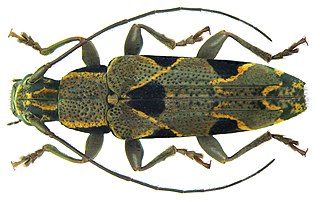
Tmesisternini is a tribe of beetles in the subfamily Lamiinae containing the following genera:
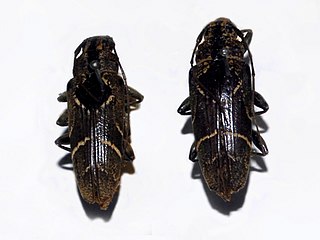
Tmesisternus is a genus of longhorn beetles belonging to the family Cerambycidae, subfamily Lamiinae.
Tmesisternus jaspideus is a species of beetle in the family Cerambycidae. It was described by Jean Baptiste Boisduval in 1835.
Tmesisternus schaumii is a species of beetle in the family Cerambycidae. It was described by Francis Polkinghorne Pascoe in 1867. It is known from Moluccas, Australia, and the Solomon Islands.
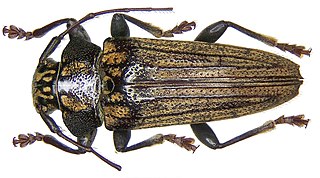
Tmesisternus venatus is a species of beetle in the family Cerambycidae. It was described by James Thomson in 1864.













